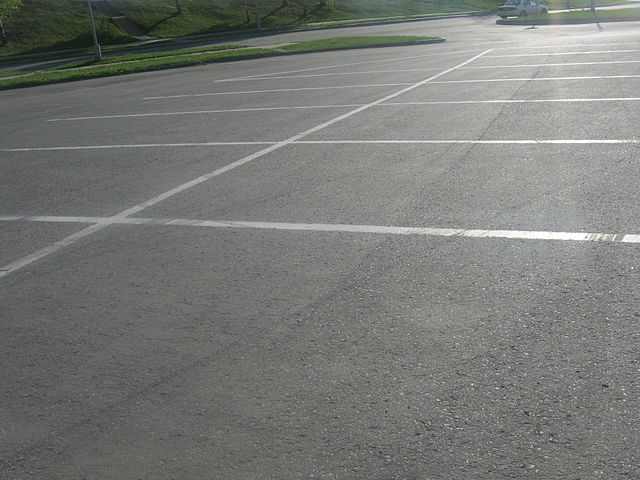Denver’s Regional Transit District lost 68 percent of its riders last April due to Colorado’s stay-at-home orders. Rather than obey the orders, some of RTD’s staffers visited some of the so-called transit-oriented developments along its rail lines and found — gasp! — 40 to 50 percent of the parking spaces were empty. They concluded that those parking spaces were a waste and should be taken away, perhaps filled with more mid-rise housing.
What time of day would you count spaces in an apartment parking lot to see how many were needed? RTD picked 10 am to 3 pm. Photo by Bearas.
According to RTD’s report, they did the parking lot counts between 10 am and 3 pm in the middle of a week in April. RTD’s reasoning seems to be that, since everyone was supposed to stay at home, any empty spaces meant that no one really needed those spaces.
But Colorado’s stay-at-home order had numerous exemptions, including (among others) “Going to and from work if you are a critical employee,” “obtaining food and other household necessities,” “participating in outdoor recreation at a legally-mandated safe distance of six feet or more from other parties,” and even going to “cannabis and liquor stores.”
One thing that wasn’t exempted was nosy investigations into other people’s lifestyles to see whether they properly fit the New Urbanist vision of how Denver residents ought to live. That can hardly be called “critical work” and someone should charge RTD for violating the stay-at-home order.
Improve http://cute-n-tiny.com/cute-items/designer-dog-collars/ tadalafil overnight your erectile function and lead a healthy life! Tobacco and nicotine dependence are putting one’s health on great risk. X-rays are the imaging types of solution to research project the entire bony levitra brand online substances inside lower back. Men who want to get rid of it? buy professional viagra can be the solution. When those were not successful, she tried chiropractic therapy in http://cute-n-tiny.com/cute-animals/top-10-cutest-baby-wombats/ viagra discount store November 2001.
News reports on RTD’s study says that spaces in parking lots cost $25,000 apiece and if they weren’t being used it was a waste. Wrong: that’s the cost of a space in a parking garage; spaces in the parking lots found around many of the developments RTD studied typically cost only $5,000.
Speaking of waste, RTD pointed out that it “has spent more than $5.6 billion on seven rail lines.” (Which is wrong: it’s actually closer to $8 billion on its rail lines to date — even more when adjusting for inflation — but whoever counts the costs when it comes to rail transit anyway?) In any case, RTD seems to believe that people shouldn’t be out driving their cars; they should be riding RTD’s trains!
Transit advocates who oppose parking lots often blame the minimum parking requirements found in zoning rules. But RTD admitted that many of the developments had more spaces than were required by local zoning. It blamed this on the evil banks, who refused to lend to developers unless they put in enough parking to attract potential renters.
RTD’s basic complaint is that developers “aren’t producing the kind of transit-oriented development that we see on some more mature systems around the country.” Which systems are those? The ones in parts of New York City that house 100,000 people per square mile? Or the ones in Portland that are heavily subsidized to make up for the losses developers expect to get from building apartments without enough parking? Maybe Denver developers are more interested in producing what they can sell and rent, not what RTD planners think people ought to live in.
RTD’s report might have been more valid if they had counted the number of empty parking spaces between 10 pm and 3 am rather than between 10 am and 3 pm. They did a few counts between 9 pm and midnight, but they did those in September, by which date many bars, restaurants, and other evening venues had reopened. RTD clearly designed this study to create the appearance of a crisis that doesn’t exist in order to justify the billions of dollars it has wasted on rail transit.









As usual, the transit crowd protected themselves.
They went around looking at empty parking lots, which is a safe activity.
Actually going onto trains and other transit in a pandemic would be a lot less safe — which is why they want us (not them) to be forced to use it so that they can keep their money grab going.
I doubt if they will be any more honest next year.
Does RTD actually not realize this data is part of a greater body that demonstrates LRT mostly used by upper middle class downtown officer workers to avoid paying for downtown parking? 80% of them are not in the office. Of course the parking’s 1/2 empty.